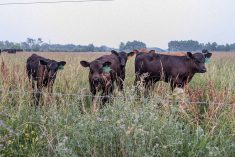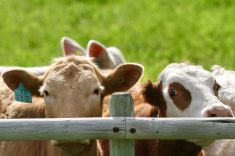The Canadian lamb market is on fire.
Unprecedented demand over the last three years has driven up prices to $1.40 a pound. That has meant lots of sheep and lambs moving from the Prairies to Eastern Canada.
“Prices have never been this high,” said sheep specialist Wray Whitmore of Alberta Agriculture.
Producers prefer to see prices rise because of greater lamb consumption instead of being edged up by short supply, said Whitmore. Some of the recent demand is due to the sharp drop in the American supply of market lambs in the last few years. Almost half of all American ewes were eliminated after sheep producers lost their wool subsidy, he said.
Read Also

U.S. farm group supports supply management
U.S. grassroots farm advocacy group pushing new agriculture legislation that would move towards supply management like Canada has for dairy industry
In addition to the short American supply, a swelling ethnic population in Eastern Canada is looking for lamb for traditional Moslem meals and religious celebrations.
Consumption of lamb is Canada is climbing beyond the average two pounds per capita a year.
For Roy Leitch, of Brandon, Man., who owns the largest lamb feedlot in Canada, these prices come with mixed blessings.
“It’s nice to see them high, but from my point of view, to put 60 lb. lambs (in a feedlot) for this kind of money is kind of scary,” said Leitch.
“They’re a little higher than what I like to see but I don’t want to see them at 60 cents either.”
As a feedlot operator with high costs for feed and feeder lambs, he works on a very tight margin.
“There’s actually less profit when they’re so high because you have to pay more to get them. Everybody wants them, so it’s a real competitive market right now,” said Leitch.
He expects lamb prices to go no lower than $1.20 this fall.
About 30 percent of his lambs sell to the United States. To further increase the supply, Leitch is opening a feedlot near Regina this fall. That puts 60,000 lambs in total on feed in Saskatchewan and Manitoba.
He sources lambs from the three prairie provinces, fattens them up to 100 to 110 lb. and assembles them for the slaughterhouses in Toronto and Montreal where they go to the large Middle Eastern immigrant market.
Chuanliang Su, markets economist with Alberta Agriculture, forecasts lamb prices will remain historically high for the rest of the year. With a strong U.S. market and low Canadian dollar, lamb markets will hold their strength.
Move to markets
The market lamb industry has become a North American market but in Canada, Su said an interesting trend has developed.
Ontario has the largest flock in Canada at 180,000 head. Alberta is second at 157,000. However trade lines have shifted and a large ratio of prairie lambs end up in Manitoba feedlots because of inexpensive feed grains and proximity to Ontario and Quebec slaughterhouses.
Prices in major markets have averaged well above three-year ranges.
After Easter, slaughter lambs at San Angelo, Texas averaged $96.40 (U.S.) per cwt. Midwest trade based on Colorado was $2-$3 lower. Feeder lambs averaged $117 in Texas while the midwest offered $100-$110 (U.S.).
As of April 17 the Edmonton stockyards reported market lambs weighing 95-110 lb. were bid at $134 per cwt., up from the March price of $128.35. Feeder lambs were at $136 for 81-94 lb., $146 for 61-80 lb. and $150 per cwt. under 60 pounds. Ewes averaged $75.70.
Light volumes were reported in all classes indicating supply is tight.
In Ontario, market prices were even higher. Market lambs in the 95-110 lb. category fetched $145.62 to $191.58 per cwt. compared to $157.26 to $178.57 the month before. Lambs in the next group of 80-94 lb. were traded at $171.05 to $210.93 per cwt. Under 80 lb. were bid at $194.27 to $219.92 on 1,375 head.















